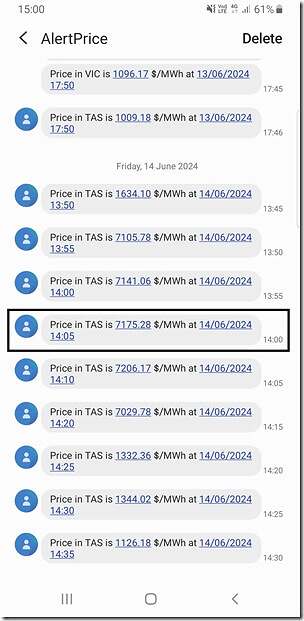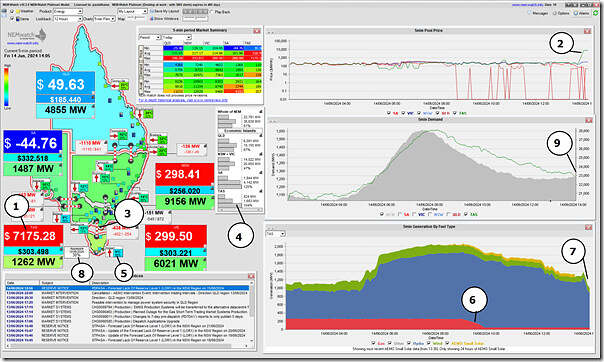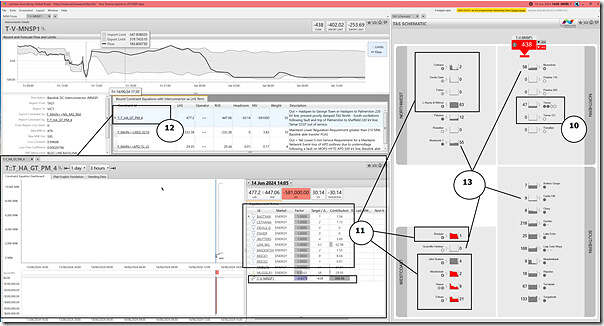A short article before our 4pm deadline today (for the newsletter to subscribers) to record the bout of volatility seen in Tasmania on Friday afternoon 14th June 2024.
We see this firstly (for prices >$1,000/MWh, which was the alert threshold) in this run of volatility captured via ‘SMS Alarms’ in ez2view today:
We see the volatility this afternoon, appended to the brief run of volatility Thursday 13th June 2024 as well.
In the image above we’ve highlighted the 14:05 dispatch interval, which is shown in more detail in this image captured from NEMwatch at the time:
With respect to the numbering:
1) The spot price in TAS is $7,175.28/MWh, which is slightly lower than the high point reached in the next dispatch interval;
2) This is the 4th dispatch interval above $1,000/MWh … but we also see it’s been above $100/MWh for most of the past 12 hours.
3) We see Basslink is cranked above the maximum running southwards
(a) -438MW flow south, which is more negative than the –402MW ‘import limit’
(b) meaning Over-Constrained Dispatch (from 13:50 to 14:10 inclusive).
4) There’s plenty of spare capacity in TAS available (i.e. an IRPM of the TAS ‘Economic Island’ so formed above 100%) … so it’s not ‘simply’ tight supply-demand balance that’s causing the volatility
5) We see it’s still cold in Hobart around the middle of the day … but the ‘Market Demand’ is in the green zone.
6) Yesterday we’d written that ‘Gas-fired generation running more strongly in TAS (and Tamar Valley CCGT for the first time) than it has over the past 5 years’ … but we see that there was a significant reduction in output this morning around ~10:00.
7) We see a significant drop in hydro generation coincident with the price spike
8) Hydro storage levels are at ~30% in aggregate for Hydro Tasmania
9) We also see a significant drop in ‘Market Demand’ coincident with the price spike and wonder if this is due, in part, to Demand Response at spot-exposed major energy users (such as several of our clients we’ve been serving in TAS for a decade or more)?
For more detail we look at this collage of a couple different widgets in ez2view today, time travelled back to the same 14:05 dispatch interval (i.e. so we don’t yet have the benefit of ‘next day public’ data (like bids), but are showing ‘end of interval’ metered values:
With respect to these annotations:
10) We see Tamar Valley CCGT was not running at this time … not in the past 2 hours at least … and only BBTHREE1 and BBTHREE2 units burning gas
11) We can clearly see that hydro units in the North-West and West-Coast zones have been ‘constrained down’
12) Reading the mouse-overs we see that this is due to the ‘T::T_HA_GT_PM_4’ constraint equation:
(a) which the AEMO describes as (i.e. on the ‘Standing Data’ tab)…
‘Out = Hadspen to George Town or Hadspen to Palmerston 220 kV line, prevent poorly damped TAS North – South oscillations following fault and trip of Palmerston to Sheffield 220 kV line, Tamar CCGT out of service.’
(b) we see that the Basslink interconnector running strong southwards is one of the contributors to the hydro units being constrained down…
i. i.e. it has a negative factor on the LHS, and flow south is negative.
ii. so this provides a large positive contribution on the LHS
(c) Not shown here, but we can use the ‘Constraint Dashboard’ widget in ez2view for the two FCAS constraints (i.e. the ‘F_MAIN++LREG_0210’ constraint equation and the ‘F_MAIN++APD_TL_L5’ constraint equation) to surmise that:
i. they are the ones leading NEMDE to direct flow strongly south,
ii. … leading to hydro generation being constrained down
iii. hence the ENERGY price popping.
13) We also see output from the 4 x Wind Farms in TAS highlighted is relatively modest:
(a) potentially being ‘constrained down’ at Musselroe Wind Farm;
(b) approximately 39% capacity factor at Woolnorth Wind Farm, which is Non-Scheduled;
(c) actually at 0MW for Granville Harbour Wind Farm, for reasons not explored at this point in time; and
(d) Almost 0MW for Cattle Hill Wind Farm, for reasons not explored at this point in time.
That’s all for now …





Something very interesting technically going on here. Sounds like one are of Tassie is electrically very weak – not many synchronous machines running and a line fault (lots of reactive needed to clear it – Basslink won’t provide that) and it all got the wobbles. MW swings you don’t want. Sounds like some power system stabilisers not doing what they are supposed to (or not enough of them in service).